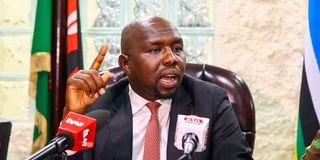Premium
Mombasa-Nairobi expressway will not hurt SGR, Murkomen assures traders

Transport CS Kipchumba Murkomen.
What you need to know:
- Local private investors were given a chance to participate in the financing of the Sh472.9 billion expressway after the Kenya National Highways Authority (KeNHA) and US-based private equity Everstron Capital LLC signed a deal to kickstart construction.
- Apart from the Mombasa-Nairobi expressway, the government is committed to extending the SGR from Naivasha to Malaba on the border with Uganda and beyond to enhance competitiveness of the Northern Transport Corridor.
Construction of a six-lane Nairobi-Mombasa expressway that is expected to reduce travel time from Kenya’s capital to the coastal city to 4.5 hours, down from 10 and a half hours, will not affect the operations of the Standard Gauge Railway (SGR), the government has said.
Roads and Transport Cabinet Secretary Kipchumba Murkomen said the toll-road deal, which involves a 440-kilometer link between Nairobi, and Mombasa that serves as a gateway for several East African economies will complement the existing infrastructures to make the Northern Corridor more competitive.
Mr Murkomen dismissed fears that once the toll road is ready, the SGR will be disadvantaged as cargo shifts to road transport.
He added that the SGR extension, the Mombasa-Nairobi Expressway and later Rironi-Mau Summit Expressway will make the Northern Corridor an irresistible option for many businesses in the East and Central African region.
“I am the CS of both roads and rail [and can assure you] the government has no intention of prioritising one over the other. We shall ensure rail and road provide seamless flow of cargo from the port of Mombasa to other parts of the region,” said Mr Murkomen.
Speaking during the launch of the Kenya Railways Strategic Plan 2023-2027, the CS said the railway intends to increase cargo volumes from 26 percent to 42 percent in 2027.
“We are challenging Kenya Railways to improve its services to attract more users so as to attain its vision. The government will not favour any mode of transport by issuing mandatory use of rail edicts to increase its volumes,” Mr Murkomen pledged.
The announcement comes few days after local private investors were given a chance to participate in the financing of the Sh472.9 billion expressway after the Kenya National Highways Authority (KeNHA) and US-based private equity Everstron Capital LLC signed a deal to kickstart construction.
"The road, dubbed ‘Usahihi’, is expected to have four to six lanes and will be constructed over the next 3-4 years.
"Usahihi will pay its way, not burdening the government as it is structured as a Public-Private Partnership with revenue coming from road users. Usahihi will organise finance, construction, tolling, operation, and maintenance of the expressway under a 30-year concession with construction lasting 3-4 years," read the press release announcing the deal.
The CS spoke a day after he held a virtual meeting with US Secretary for Transportation Pete Buttigieg on several areas of cooperation, including road safety, mass rapid transport and aviation.
Mr Murkomen and Mr Buttigieg discussed green transport in the Nairobi Metropolitan Area and explored avenues for knowledge exchange and capacity building in the sector.
Apart from the Mombasa-Nairobi expressway, the government is committed to extending the SGR from Naivasha to Malaba on the border with Uganda and beyond to enhance competitiveness of the Northern Transport Corridor.
“To this end, we will collaborate with the Interstate Ministerial Committee on the SGR Cluster to explore viable financial options to ensure that SGR extends from Malaba through Kasese in Uganda and finally Kisangani, in the DR Congo, to boost regional trade,” said Mr Murkomen.
He said the Kenya Railways Strategic Plan 2023-2027 is meant to steer the implementation of priority initiatives in the rail transport sector over the next five years.
The Plan outlines ambitious goals for Kenya Railways, including the development and enhancement of rail infrastructure, expansion of freight and passenger transport, increasing market share of the port of Mombasa, fostering a skilled workforce, and institutionalising Environmental, Social, and Governance standards.





